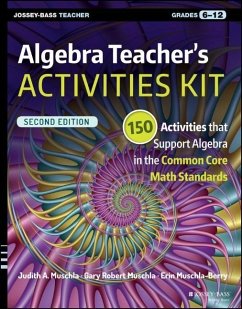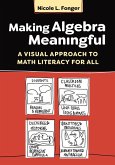Judith A Muschla, Gary R Muschla, Erin Muschla-Berry
Algebra Teacher's Activities Kit
150 Activities That Support Algebra in the Common Core Math Standards, Grades 6-12
27,99 €
inkl. MwSt.
Versandfertig in über 4 Wochen

14 °P sammeln
Judith A Muschla, Gary R Muschla, Erin Muschla-Berry
Algebra Teacher's Activities Kit
150 Activities That Support Algebra in the Common Core Math Standards, Grades 6-12
- Broschiertes Buch
- Merkliste
- Auf die Merkliste
- Bewerten Bewerten
- Teilen
- Produkt teilen
- Produkterinnerung
- Produkterinnerung
Help your students succeed with classroom-ready, standards-based activities The Algebra Teacher's Activities Kit: 150 Activities That Support Algebra in the Common Core Math Standards helps you bring the standards into your algebra classroom with a range of engaging activities that reinforce fundamental algebra skills. This newly updated second edition is formatted for easy implementation, with teaching notes and answers followed by reproducibles for activities covering the algebra standards for grades 6 through 12. Coverage includes whole numbers, variables, equations, inequalities, graphing,…mehr
Andere Kunden interessierten sich auch für
![The Algebra Teacher's Activity-a-Day, Grades 6-12 The Algebra Teacher's Activity-a-Day, Grades 6-12]() Frances Mcbroom ThompsonThe Algebra Teacher's Activity-a-Day, Grades 6-1218,99 €
Frances Mcbroom ThompsonThe Algebra Teacher's Activity-a-Day, Grades 6-1218,99 €![The Successful Teacher's Survival Kit The Successful Teacher's Survival Kit]() Dale RipleyThe Successful Teacher's Survival Kit84,99 €
Dale RipleyThe Successful Teacher's Survival Kit84,99 €![The Successful Teacher's Survival Kit The Successful Teacher's Survival Kit]() Dale RipleyThe Successful Teacher's Survival Kit45,99 €
Dale RipleyThe Successful Teacher's Survival Kit45,99 €![Making Algebra Meaningful Making Algebra Meaningful]() Nicole L FongerMaking Algebra Meaningful132,99 €
Nicole L FongerMaking Algebra Meaningful132,99 €![Didaktische Probleme der elementaren Algebra Didaktische Probleme der elementaren Algebra]() Günther MalleDidaktische Probleme der elementaren Algebra59,99 €
Günther MalleDidaktische Probleme der elementaren Algebra59,99 €![Writing Portfolio Activities Kit Writing Portfolio Activities Kit]() Mary Ellen LedbetterWriting Portfolio Activities Kit27,99 €
Mary Ellen LedbetterWriting Portfolio Activities Kit27,99 €![Human Biology Activities Kit Human Biology Activities Kit]() John R RolandHuman Biology Activities Kit31,99 €
John R RolandHuman Biology Activities Kit31,99 €-
-
-
Help your students succeed with classroom-ready, standards-based activities The Algebra Teacher's Activities Kit: 150 Activities That Support Algebra in the Common Core Math Standards helps you bring the standards into your algebra classroom with a range of engaging activities that reinforce fundamental algebra skills. This newly updated second edition is formatted for easy implementation, with teaching notes and answers followed by reproducibles for activities covering the algebra standards for grades 6 through 12. Coverage includes whole numbers, variables, equations, inequalities, graphing, polynomials, factoring, logarithmic functions, statistics, and more, and gives you the material you need to reach students of various abilities and learning styles. Many of these activities are self-correcting, adding interest for students and saving you time. This book provides dozens of activities that * Directly address each Common Core algebra standard * Engage students and get them excited about math * Are tailored to a diverse range of levels and abilities * Reinforce fundamental skills and demonstrate everyday relevance Algebra lays the groundwork for every math class that comes after it, so it's crucial that students master the material and gain confidence in their abilities. The Algebra Teacher's Activities Kit helps you face the challenge, well-armed with effective activities that help students become successful in algebra class and beyond.
Hinweis: Dieser Artikel kann nur an eine deutsche Lieferadresse ausgeliefert werden.
Hinweis: Dieser Artikel kann nur an eine deutsche Lieferadresse ausgeliefert werden.
Produktdetails
- Produktdetails
- Verlag: John Wiley & Sons / Wiley
- 2nd Revised edition
- Seitenzahl: 336
- Erscheinungstermin: 21. Dezember 2015
- Englisch
- Abmessung: 272mm x 216mm x 15mm
- Gewicht: 771g
- ISBN-13: 9781119045748
- ISBN-10: 1119045746
- Artikelnr.: 42791994
- Herstellerkennzeichnung
- Libri GmbH
- Europaallee 1
- 36244 Bad Hersfeld
- gpsr@libri.de
- Verlag: John Wiley & Sons / Wiley
- 2nd Revised edition
- Seitenzahl: 336
- Erscheinungstermin: 21. Dezember 2015
- Englisch
- Abmessung: 272mm x 216mm x 15mm
- Gewicht: 771g
- ISBN-13: 9781119045748
- ISBN-10: 1119045746
- Artikelnr.: 42791994
- Herstellerkennzeichnung
- Libri GmbH
- Europaallee 1
- 36244 Bad Hersfeld
- gpsr@libri.de
Judith A. Muschla has taught mathematics in South River, New Jersey, for over twenty-five years. Along with teaching and writing, she has been a member of the state Standards Review Panel for the Mathematics Core Curriculum Content Standards in New Jersey. Gary Robert Muschla taught at Appleby School in Spotswood, New Jersey, for more than twenty-five years; his specialties include mathematics at the middle school level, reading, and writing. Judith and Gary have coauthored several successful math activity books, including Teaching the Common Core Math Standards with Hands on Activities, Grades 9-12, Hands-On Math Projects with Real Life Applications, The Math Teacher's Book of Lists, and Math Starters. Erin Muschla-Berry teaches 8th grade math at Monroe Township Middle School in Monroe, New Jersey, and has collaborated with Judith and Gary on eight previous math books.
About the Authors vii Acknowledgments ix Preface xvii SECTION 1: RATIOS AND PROPORTIONAL RELATIONSHIPS 1 Teaching Notes for the Activities of Section 1 2 1
1: (6.RP.1) Understanding Ratios 2 1
2: (6.RP.2) Unit Rates and Ratios 2 1
3: (6.RP.3) Equivalent Ratios and the Coordinate Plane 3 1
4: (6.RP.3) Finding the Percent of a Number and Finding the Whole 3 1
5: (7.RP.1) Finding Unit Rates 4 1
6: (7.RP.2) Graphing Proportional Relationships 4 1
7: (7.RP.2) Representing Proportional Relationships 5 1
8: (7.RP.3) Solving Word Problems Involving Percents 5 Reproducibles for Section 1 6 SECTION 2: THE NUMBER SYSTEM AND NUMBER AND QUANTITY 19 Teaching Notes for the Activities of Section 2 20 2
1: (6.NS.5) Representing Positive and Negative Numbers 20 2
2: (6.NS.6) Graphing Rational Numbers on a Number Line 20 2
3: (6.NS.6) Graphing Points in the Coordinate Plane 21 2
4: (6.NS.7) The Absolute Value and Order of Rational Numbers 22 2
5: (6.NS.8) Using the Coordinate Plane to Solve Problems 22 2
6: (7.NS.1) Using the Number Line to Add and Subtract Rational Numbers23 2
7: (7.NS.1) Using Properties to Add and Subtract Rational Numbers 24 2
8: (7.NS.2) Multiplying and Dividing Rational Numbers 25 2
9: (7.NS.2) Converting Rational Numbers to Decimals26 2
10: (7.NS.3) Solving Word Problems Involving Rational Numbers 27 2
11: (8.NS.1) Expressing Fractions as Repeating Decimals and Repeating Decimals as Fractions 27 2
12: (8.NS.2) Using Rational Approximations of Irrational Numbers 28 2
13: (N
RN.1) Using the Properties of Exponents29 2
14: (N
RN.2) Rewriting Expressions Involving Radicals and Rational Exponents 29 2
15: (N
RN.3) Sums and Products of Rational and Irrational Numbers 30 2
16: (N
Q.1) Interpreting and Using Units 31 2
17: (N
Q.2) Defining Appropriate Quantities 31 2
18: (N
Q.3) Choosing Appropriate Levels of Accuracy for Measurement 32 2
19: (N
CN.1) Writing Complex Numbers 33 2
20: (N
CN.2) Adding, Subtracting, and Multiplying Complex Numbers 34 2
21: (N
CN.7) Solving Quadratic Equations That Have Complex Solutions 34 Reproducibles for Section 2 35 SECTION 3: BASIC EXPRESSIONS, EQUATIONS, AND INEQUALITIES 60 Teaching Notes for the Activities of Section 3 61 3
1: (6.EE.1) Writing and Evaluating Numerical Expressions with Whole
Number Exponents 61 3
2: (6.EE.2) Writing and Reading Algebraic Expressions 62 3
3: (6.EE.2) Evaluating Algebraic Expressions 62 3
4: (6.EE.3) Applying Properties of Operations to Generate Equivalent Expressions 63 3
5: (6.EE.4) Identifying Equivalent Expressions 63 3
6: (6.EE.5) Identifying Solutions of Equations and Inequalities 64 3
7: (6.EE.6) Writing Expressions in Which Variables Represent Numbers 64 3
8: (6.EE.7) Writing and Solving Equations 65 3
9: (6.EE.8) Using Inequalities 65 3
10: (6.EE.9) Using Variables to Represent Two Quantities 66 3
11: (7.EE.1) Adding, Subtracting, Factoring, and Expanding Linear Expressions 67 3
12: (7.EE.2) Rewriting Expressions in Different Forms 67 3
13: (7.EE.3) Solving Multi
Step Problems 68 3
14: (7.EE.4) Solving Equations and Inequalities 68 3
15: (8.EE.1) Applying Properties of Integer Exponents 69 3
16: (8.EE.2) Using Square Roots and Cube Roots 69 3
17: (8.EE.3) Using Numbers Expressed in Scientific Notation 70 3
18: (8.EE.4) Operations with Scientific Notation 71 3
19: (8.EE.5) Graphing Proportional Relationships 71 3
20: (8.EE.6) Deriving the Equation y = mx 72 3
21: (8.EE.7) Identifying Equations That Have One Solution, No Solutions, or Infinitely Many Solutions 73 3
22: (8.EE.7) Solving Equations with Variables on Both Sides 73 3
23: (8.EE.8) Solving Systems of Linear Equations Algebraically 74 3
24: (8.EE.8) Solving Systems of Equations by Graphing 75 Reproducibles for Section 3 75 SECTION 4: POLYNOMIAL, RATIONAL, EXPONENTIAL, AND RADICAL EXPRESSIONS, EQUATIONS, AND INEQUALITIES 103 Teaching Notes for the Activities of Section 4 104 4
1: (A
SSE.1) Interpreting Expressions 104 4
2: (A
SSE.2) Using the Structure of an Expression to Identify Ways to Rewrite It 104 4
3: (A
SSE.3) Factoring Quadratic Expressions to Reveal Zeroes 105 4
4: (A
SSE.3) Completing the Square to Reveal Maximum or Minimum Values 106 4
5: (A
SSE.4) Finding Sums of Finite Geometric Series 106 4
6: (A
APR.1) Adding, Subtracting, and Multiplying Polynomials 107 4
7: (A
APR.2) Applying the Remainder Theorem 107 4
8: (A
APR.3) Using Zeroes to Construct a Rough Graph of a Polynomial Function 108 4
9: (A
APR.4) Proving Polynomial Identities 109 4
10: (A
APR.6) Rewriting Rational Expressions 110 4
11: (A
CED.1) Writing and Solving Equations and Inequalities in One Variable 111 4
12: (A
CED.2) Writing and Graphing Equations in Two Variables 111 4
13: (A
CED.3) Representing Constraints and Interpreting Solutions 112 4
14: (A
CED.4) Highlighting Quantities of Interest in Formulas 113 4
15: (A
REI.1) Justifying Solutions to Equations 113 4
16: (A
REI.2) Solving Rational and Radical Equations 114 4
17: (A
REI.3) Solving Multi
Step Linear Equations in One Variable 115 4
18: (A
REI.3) Solving Multi
Step Linear Inequalities in One Variable 115 4
19: (A
REI.4) Solving a Quadratic Equation by Completing the Square 116 4
20: (A
REI.4) Solving Quadratic Equations in a Variety of Ways 116 4
21: (A
REI.5) Solving Systems of Equations 117 4
22: (A
REI.6) Solving Systems of Linear Equations 118 4
23: (A.REI.7) Solving a System of a Linear and a Quadratic Equation 118 4
24: (A
REI.10) Relating Graphs to the Solutions of Equations 119 4
25: (A
REI.11) Using Graphs and Tables to Find Solutions to Systems of Equations 120 4
26: (A
REI.12) Solving Systems of Inequalities by Graphing 120 Reproducibles for Section 4 121 SECTION 5: FUNCTIONS 155 Teaching Notes for the Activities of Section 5 156 5
1: (8.F.1) Identifying Functions 156 5
2: (8.F.2) Comparing Functions 157 5
3: (8.F.3) Determining Whether Data Lies on a Line 157 5
4: (8.F.4) Finding the Slope and Y
Intercept of a Line 157 5
5: (8.F.5) Analyzing and Graphing Functions 158 5
6: (F
IF.1) Understanding Functions 159 5
7: (F
IF.2) Finding the Values of Functions 159 5
8: (F
IF.3) Defining Sequences Recursively 160 5
9: (F
IF.4) Identifying Key Features of Graphs 160 5
10: (F
IF.5) Relating the Domain of a Function to Its Graph or Description 161 5
11: (F
IF.6) Finding the Average Rate of Change over Specified Intervals 162 5
12: (F
IF.7) Graphing Linear and Quadratic Functions 162 5
13: (F
IF.7) Graphing Polynomial Functions 163 5
14: (F
IF.8) Rewriting Quadratic Equations 164 5
15: (F
IF.9) Comparing Properties of Functions 165 5
16: (F
BF.1) Writing Functions 165 5
17: (F
BF.2) Writing Arithmetic and Geometric Sequences 166 5
18: (F
BF.3) Transforming a Function 166 5
19: (F
BF.4) Finding the Inverses of Functions 167 5
20: (F
LE.1) Proving Linear Functions Grow by Equal Differences over Equal Intervals 168 5
21: (F
LE.1) Proving Exponential Functions Grow by Equal Factors over Equal Intervals 168 5
22: (F
LE.2) Constructing Linear and Exponential Functions 169 5
23: (F
LE.3) Observing the Behavior of Quantities That Increase Exponentially 170 5
24: (F
LE.4) Writing and Solving Exponential Equations 170 5
25: (F
LE.5) Interpreting Parameters in a Linear or Exponential Function 171 5
26: (F
TF.1) Using Radian and Degree Measures 172 5
27: (F
TF.2) Using the Unit Circle 172 5
28: (F
TF.5) Modeling Periodic Phenomena 173 5
29: (F
TF.8) Finding the Values of the Sine, Cosine, and Tangent Functions 174 Reproducibles for Section 5 175 SECTION 6: STATISTICS AND PROBABILITY 221 Teaching Notes for the Activities of Section 6 222 6
1: (6.SP.1) Identifying Statistical Questions 222 6
2: (6.SP.2) Describing Data Distributions 222 6
3: (6.SP.3) Finding the Mean, Median, Mode, and Range 223 6
4: (6.SP.4) Using Dot Plots to Display Data 224 6
5: (6.SP.4) Constructing a Box Plot 224 6
6: (6.SP.5) Summarizing and Describing Data 225 6
7: (7.SP.1) Drawing Inferences from Samples 227 6
8: (7.SP.2) Drawing Inferences about a Population Using Random Samples 227 6
9: (7.SP.3) Comparing Two Data Sets 228 6
10: (7.SP.4) Drawing Inferences about Populations 229 6
11: (7.SP.5) Understanding the Probability of Events 229 6
12: (7.SP.6) Probabilities and Predictions 230 6
13: (7.SP.7) Using Probability Models to Find Probabilities of Events 230 6
14: (7.SP.8) Understanding the Probability of Compound Events 231 6
15: (7.SP.8) Finding Probabilities of Compound Events Using Tables, Lists, and Tree Diagrams 232 6
16: (8.SP.1) Constructing and Interpreting Scatter Plots 233 6
17: (8.SP.2) Fitting Lines to Data 234 6
18: (8.SP.3) Using Equations of Linear Models234 6
19: (8.SP.4) Constructing and Interpreting Two
Way Tables 235 6
20: (S
ID.1) Representing Data with Plots on the Real Number Line 236 6
21: (S
ID.2) Comparing Two Data Sets 236 6
22: (S
ID.3) Interpreting Differences in Shape, Center, and Spread of Data Distributions 237 6
23: (S
ID.4) Recognizing Characteristics of Normal Distributions 238 6
24: (S
ID.5) Summarizing Categorical Data in Two
Way Frequency Tables 238 6
25: (S
ID.6) Finding the Equation of the Line of Best Fit 239 6
26: (S
ID.6) Using Linear and Quadratic Models 240 6
27: (S
ID.7) Interpreting the Slope and Y
Intercept of a Linear Model 241 6
28: (S
ID.8) Computing and Interpreting the Correlation Coefficient 241 6
29: (S
ID.9) Distinguishing between Correlation and Causation 242 6
30: (S
IC.1) Understanding the Terminology of Statistical Experiments 242 6
31: (S
IC.2) Evaluating Probability Models through Simulations 243 6
32: (S
IC.3) Recognizing Surveys, Experiments, and Observational Studies 244 6
33: (S
IC.4) Using Simulations with Random Sampling 244 6
34: (S
IC.5) Comparing Two Treatments Using Simulations 245 6
35: (S
IC.6) Evaluating Data in Reports 246 6
36: (S
CP.1) Describing Events as Subsets of a Sample Space 246 6
37: (S
CP.2) Identifying Independent Events 247 6
38: (S
CP.3) Interpreting Conditional Probability 247 6
39: (S
CP.4) Understanding Two
Way Frequency Tables 248 6
40: (S
CP.5) Exploring Concepts of Conditional Probability 249 6
41: (S
CP.6) Finding Conditional Probabilities as a Fraction of Outcomes 249 6
42: (S
CP.7) Applying the Addition Rule 250 Reproducibles for Section 6 250 INDEX 305
1: (6.RP.1) Understanding Ratios 2 1
2: (6.RP.2) Unit Rates and Ratios 2 1
3: (6.RP.3) Equivalent Ratios and the Coordinate Plane 3 1
4: (6.RP.3) Finding the Percent of a Number and Finding the Whole 3 1
5: (7.RP.1) Finding Unit Rates 4 1
6: (7.RP.2) Graphing Proportional Relationships 4 1
7: (7.RP.2) Representing Proportional Relationships 5 1
8: (7.RP.3) Solving Word Problems Involving Percents 5 Reproducibles for Section 1 6 SECTION 2: THE NUMBER SYSTEM AND NUMBER AND QUANTITY 19 Teaching Notes for the Activities of Section 2 20 2
1: (6.NS.5) Representing Positive and Negative Numbers 20 2
2: (6.NS.6) Graphing Rational Numbers on a Number Line 20 2
3: (6.NS.6) Graphing Points in the Coordinate Plane 21 2
4: (6.NS.7) The Absolute Value and Order of Rational Numbers 22 2
5: (6.NS.8) Using the Coordinate Plane to Solve Problems 22 2
6: (7.NS.1) Using the Number Line to Add and Subtract Rational Numbers23 2
7: (7.NS.1) Using Properties to Add and Subtract Rational Numbers 24 2
8: (7.NS.2) Multiplying and Dividing Rational Numbers 25 2
9: (7.NS.2) Converting Rational Numbers to Decimals26 2
10: (7.NS.3) Solving Word Problems Involving Rational Numbers 27 2
11: (8.NS.1) Expressing Fractions as Repeating Decimals and Repeating Decimals as Fractions 27 2
12: (8.NS.2) Using Rational Approximations of Irrational Numbers 28 2
13: (N
RN.1) Using the Properties of Exponents29 2
14: (N
RN.2) Rewriting Expressions Involving Radicals and Rational Exponents 29 2
15: (N
RN.3) Sums and Products of Rational and Irrational Numbers 30 2
16: (N
Q.1) Interpreting and Using Units 31 2
17: (N
Q.2) Defining Appropriate Quantities 31 2
18: (N
Q.3) Choosing Appropriate Levels of Accuracy for Measurement 32 2
19: (N
CN.1) Writing Complex Numbers 33 2
20: (N
CN.2) Adding, Subtracting, and Multiplying Complex Numbers 34 2
21: (N
CN.7) Solving Quadratic Equations That Have Complex Solutions 34 Reproducibles for Section 2 35 SECTION 3: BASIC EXPRESSIONS, EQUATIONS, AND INEQUALITIES 60 Teaching Notes for the Activities of Section 3 61 3
1: (6.EE.1) Writing and Evaluating Numerical Expressions with Whole
Number Exponents 61 3
2: (6.EE.2) Writing and Reading Algebraic Expressions 62 3
3: (6.EE.2) Evaluating Algebraic Expressions 62 3
4: (6.EE.3) Applying Properties of Operations to Generate Equivalent Expressions 63 3
5: (6.EE.4) Identifying Equivalent Expressions 63 3
6: (6.EE.5) Identifying Solutions of Equations and Inequalities 64 3
7: (6.EE.6) Writing Expressions in Which Variables Represent Numbers 64 3
8: (6.EE.7) Writing and Solving Equations 65 3
9: (6.EE.8) Using Inequalities 65 3
10: (6.EE.9) Using Variables to Represent Two Quantities 66 3
11: (7.EE.1) Adding, Subtracting, Factoring, and Expanding Linear Expressions 67 3
12: (7.EE.2) Rewriting Expressions in Different Forms 67 3
13: (7.EE.3) Solving Multi
Step Problems 68 3
14: (7.EE.4) Solving Equations and Inequalities 68 3
15: (8.EE.1) Applying Properties of Integer Exponents 69 3
16: (8.EE.2) Using Square Roots and Cube Roots 69 3
17: (8.EE.3) Using Numbers Expressed in Scientific Notation 70 3
18: (8.EE.4) Operations with Scientific Notation 71 3
19: (8.EE.5) Graphing Proportional Relationships 71 3
20: (8.EE.6) Deriving the Equation y = mx 72 3
21: (8.EE.7) Identifying Equations That Have One Solution, No Solutions, or Infinitely Many Solutions 73 3
22: (8.EE.7) Solving Equations with Variables on Both Sides 73 3
23: (8.EE.8) Solving Systems of Linear Equations Algebraically 74 3
24: (8.EE.8) Solving Systems of Equations by Graphing 75 Reproducibles for Section 3 75 SECTION 4: POLYNOMIAL, RATIONAL, EXPONENTIAL, AND RADICAL EXPRESSIONS, EQUATIONS, AND INEQUALITIES 103 Teaching Notes for the Activities of Section 4 104 4
1: (A
SSE.1) Interpreting Expressions 104 4
2: (A
SSE.2) Using the Structure of an Expression to Identify Ways to Rewrite It 104 4
3: (A
SSE.3) Factoring Quadratic Expressions to Reveal Zeroes 105 4
4: (A
SSE.3) Completing the Square to Reveal Maximum or Minimum Values 106 4
5: (A
SSE.4) Finding Sums of Finite Geometric Series 106 4
6: (A
APR.1) Adding, Subtracting, and Multiplying Polynomials 107 4
7: (A
APR.2) Applying the Remainder Theorem 107 4
8: (A
APR.3) Using Zeroes to Construct a Rough Graph of a Polynomial Function 108 4
9: (A
APR.4) Proving Polynomial Identities 109 4
10: (A
APR.6) Rewriting Rational Expressions 110 4
11: (A
CED.1) Writing and Solving Equations and Inequalities in One Variable 111 4
12: (A
CED.2) Writing and Graphing Equations in Two Variables 111 4
13: (A
CED.3) Representing Constraints and Interpreting Solutions 112 4
14: (A
CED.4) Highlighting Quantities of Interest in Formulas 113 4
15: (A
REI.1) Justifying Solutions to Equations 113 4
16: (A
REI.2) Solving Rational and Radical Equations 114 4
17: (A
REI.3) Solving Multi
Step Linear Equations in One Variable 115 4
18: (A
REI.3) Solving Multi
Step Linear Inequalities in One Variable 115 4
19: (A
REI.4) Solving a Quadratic Equation by Completing the Square 116 4
20: (A
REI.4) Solving Quadratic Equations in a Variety of Ways 116 4
21: (A
REI.5) Solving Systems of Equations 117 4
22: (A
REI.6) Solving Systems of Linear Equations 118 4
23: (A.REI.7) Solving a System of a Linear and a Quadratic Equation 118 4
24: (A
REI.10) Relating Graphs to the Solutions of Equations 119 4
25: (A
REI.11) Using Graphs and Tables to Find Solutions to Systems of Equations 120 4
26: (A
REI.12) Solving Systems of Inequalities by Graphing 120 Reproducibles for Section 4 121 SECTION 5: FUNCTIONS 155 Teaching Notes for the Activities of Section 5 156 5
1: (8.F.1) Identifying Functions 156 5
2: (8.F.2) Comparing Functions 157 5
3: (8.F.3) Determining Whether Data Lies on a Line 157 5
4: (8.F.4) Finding the Slope and Y
Intercept of a Line 157 5
5: (8.F.5) Analyzing and Graphing Functions 158 5
6: (F
IF.1) Understanding Functions 159 5
7: (F
IF.2) Finding the Values of Functions 159 5
8: (F
IF.3) Defining Sequences Recursively 160 5
9: (F
IF.4) Identifying Key Features of Graphs 160 5
10: (F
IF.5) Relating the Domain of a Function to Its Graph or Description 161 5
11: (F
IF.6) Finding the Average Rate of Change over Specified Intervals 162 5
12: (F
IF.7) Graphing Linear and Quadratic Functions 162 5
13: (F
IF.7) Graphing Polynomial Functions 163 5
14: (F
IF.8) Rewriting Quadratic Equations 164 5
15: (F
IF.9) Comparing Properties of Functions 165 5
16: (F
BF.1) Writing Functions 165 5
17: (F
BF.2) Writing Arithmetic and Geometric Sequences 166 5
18: (F
BF.3) Transforming a Function 166 5
19: (F
BF.4) Finding the Inverses of Functions 167 5
20: (F
LE.1) Proving Linear Functions Grow by Equal Differences over Equal Intervals 168 5
21: (F
LE.1) Proving Exponential Functions Grow by Equal Factors over Equal Intervals 168 5
22: (F
LE.2) Constructing Linear and Exponential Functions 169 5
23: (F
LE.3) Observing the Behavior of Quantities That Increase Exponentially 170 5
24: (F
LE.4) Writing and Solving Exponential Equations 170 5
25: (F
LE.5) Interpreting Parameters in a Linear or Exponential Function 171 5
26: (F
TF.1) Using Radian and Degree Measures 172 5
27: (F
TF.2) Using the Unit Circle 172 5
28: (F
TF.5) Modeling Periodic Phenomena 173 5
29: (F
TF.8) Finding the Values of the Sine, Cosine, and Tangent Functions 174 Reproducibles for Section 5 175 SECTION 6: STATISTICS AND PROBABILITY 221 Teaching Notes for the Activities of Section 6 222 6
1: (6.SP.1) Identifying Statistical Questions 222 6
2: (6.SP.2) Describing Data Distributions 222 6
3: (6.SP.3) Finding the Mean, Median, Mode, and Range 223 6
4: (6.SP.4) Using Dot Plots to Display Data 224 6
5: (6.SP.4) Constructing a Box Plot 224 6
6: (6.SP.5) Summarizing and Describing Data 225 6
7: (7.SP.1) Drawing Inferences from Samples 227 6
8: (7.SP.2) Drawing Inferences about a Population Using Random Samples 227 6
9: (7.SP.3) Comparing Two Data Sets 228 6
10: (7.SP.4) Drawing Inferences about Populations 229 6
11: (7.SP.5) Understanding the Probability of Events 229 6
12: (7.SP.6) Probabilities and Predictions 230 6
13: (7.SP.7) Using Probability Models to Find Probabilities of Events 230 6
14: (7.SP.8) Understanding the Probability of Compound Events 231 6
15: (7.SP.8) Finding Probabilities of Compound Events Using Tables, Lists, and Tree Diagrams 232 6
16: (8.SP.1) Constructing and Interpreting Scatter Plots 233 6
17: (8.SP.2) Fitting Lines to Data 234 6
18: (8.SP.3) Using Equations of Linear Models234 6
19: (8.SP.4) Constructing and Interpreting Two
Way Tables 235 6
20: (S
ID.1) Representing Data with Plots on the Real Number Line 236 6
21: (S
ID.2) Comparing Two Data Sets 236 6
22: (S
ID.3) Interpreting Differences in Shape, Center, and Spread of Data Distributions 237 6
23: (S
ID.4) Recognizing Characteristics of Normal Distributions 238 6
24: (S
ID.5) Summarizing Categorical Data in Two
Way Frequency Tables 238 6
25: (S
ID.6) Finding the Equation of the Line of Best Fit 239 6
26: (S
ID.6) Using Linear and Quadratic Models 240 6
27: (S
ID.7) Interpreting the Slope and Y
Intercept of a Linear Model 241 6
28: (S
ID.8) Computing and Interpreting the Correlation Coefficient 241 6
29: (S
ID.9) Distinguishing between Correlation and Causation 242 6
30: (S
IC.1) Understanding the Terminology of Statistical Experiments 242 6
31: (S
IC.2) Evaluating Probability Models through Simulations 243 6
32: (S
IC.3) Recognizing Surveys, Experiments, and Observational Studies 244 6
33: (S
IC.4) Using Simulations with Random Sampling 244 6
34: (S
IC.5) Comparing Two Treatments Using Simulations 245 6
35: (S
IC.6) Evaluating Data in Reports 246 6
36: (S
CP.1) Describing Events as Subsets of a Sample Space 246 6
37: (S
CP.2) Identifying Independent Events 247 6
38: (S
CP.3) Interpreting Conditional Probability 247 6
39: (S
CP.4) Understanding Two
Way Frequency Tables 248 6
40: (S
CP.5) Exploring Concepts of Conditional Probability 249 6
41: (S
CP.6) Finding Conditional Probabilities as a Fraction of Outcomes 249 6
42: (S
CP.7) Applying the Addition Rule 250 Reproducibles for Section 6 250 INDEX 305
About the Authors vii Acknowledgments ix Preface xvii SECTION 1: RATIOS AND PROPORTIONAL RELATIONSHIPS 1 Teaching Notes for the Activities of Section 1 2 1
1: (6.RP.1) Understanding Ratios 2 1
2: (6.RP.2) Unit Rates and Ratios 2 1
3: (6.RP.3) Equivalent Ratios and the Coordinate Plane 3 1
4: (6.RP.3) Finding the Percent of a Number and Finding the Whole 3 1
5: (7.RP.1) Finding Unit Rates 4 1
6: (7.RP.2) Graphing Proportional Relationships 4 1
7: (7.RP.2) Representing Proportional Relationships 5 1
8: (7.RP.3) Solving Word Problems Involving Percents 5 Reproducibles for Section 1 6 SECTION 2: THE NUMBER SYSTEM AND NUMBER AND QUANTITY 19 Teaching Notes for the Activities of Section 2 20 2
1: (6.NS.5) Representing Positive and Negative Numbers 20 2
2: (6.NS.6) Graphing Rational Numbers on a Number Line 20 2
3: (6.NS.6) Graphing Points in the Coordinate Plane 21 2
4: (6.NS.7) The Absolute Value and Order of Rational Numbers 22 2
5: (6.NS.8) Using the Coordinate Plane to Solve Problems 22 2
6: (7.NS.1) Using the Number Line to Add and Subtract Rational Numbers23 2
7: (7.NS.1) Using Properties to Add and Subtract Rational Numbers 24 2
8: (7.NS.2) Multiplying and Dividing Rational Numbers 25 2
9: (7.NS.2) Converting Rational Numbers to Decimals26 2
10: (7.NS.3) Solving Word Problems Involving Rational Numbers 27 2
11: (8.NS.1) Expressing Fractions as Repeating Decimals and Repeating Decimals as Fractions 27 2
12: (8.NS.2) Using Rational Approximations of Irrational Numbers 28 2
13: (N
RN.1) Using the Properties of Exponents29 2
14: (N
RN.2) Rewriting Expressions Involving Radicals and Rational Exponents 29 2
15: (N
RN.3) Sums and Products of Rational and Irrational Numbers 30 2
16: (N
Q.1) Interpreting and Using Units 31 2
17: (N
Q.2) Defining Appropriate Quantities 31 2
18: (N
Q.3) Choosing Appropriate Levels of Accuracy for Measurement 32 2
19: (N
CN.1) Writing Complex Numbers 33 2
20: (N
CN.2) Adding, Subtracting, and Multiplying Complex Numbers 34 2
21: (N
CN.7) Solving Quadratic Equations That Have Complex Solutions 34 Reproducibles for Section 2 35 SECTION 3: BASIC EXPRESSIONS, EQUATIONS, AND INEQUALITIES 60 Teaching Notes for the Activities of Section 3 61 3
1: (6.EE.1) Writing and Evaluating Numerical Expressions with Whole
Number Exponents 61 3
2: (6.EE.2) Writing and Reading Algebraic Expressions 62 3
3: (6.EE.2) Evaluating Algebraic Expressions 62 3
4: (6.EE.3) Applying Properties of Operations to Generate Equivalent Expressions 63 3
5: (6.EE.4) Identifying Equivalent Expressions 63 3
6: (6.EE.5) Identifying Solutions of Equations and Inequalities 64 3
7: (6.EE.6) Writing Expressions in Which Variables Represent Numbers 64 3
8: (6.EE.7) Writing and Solving Equations 65 3
9: (6.EE.8) Using Inequalities 65 3
10: (6.EE.9) Using Variables to Represent Two Quantities 66 3
11: (7.EE.1) Adding, Subtracting, Factoring, and Expanding Linear Expressions 67 3
12: (7.EE.2) Rewriting Expressions in Different Forms 67 3
13: (7.EE.3) Solving Multi
Step Problems 68 3
14: (7.EE.4) Solving Equations and Inequalities 68 3
15: (8.EE.1) Applying Properties of Integer Exponents 69 3
16: (8.EE.2) Using Square Roots and Cube Roots 69 3
17: (8.EE.3) Using Numbers Expressed in Scientific Notation 70 3
18: (8.EE.4) Operations with Scientific Notation 71 3
19: (8.EE.5) Graphing Proportional Relationships 71 3
20: (8.EE.6) Deriving the Equation y = mx 72 3
21: (8.EE.7) Identifying Equations That Have One Solution, No Solutions, or Infinitely Many Solutions 73 3
22: (8.EE.7) Solving Equations with Variables on Both Sides 73 3
23: (8.EE.8) Solving Systems of Linear Equations Algebraically 74 3
24: (8.EE.8) Solving Systems of Equations by Graphing 75 Reproducibles for Section 3 75 SECTION 4: POLYNOMIAL, RATIONAL, EXPONENTIAL, AND RADICAL EXPRESSIONS, EQUATIONS, AND INEQUALITIES 103 Teaching Notes for the Activities of Section 4 104 4
1: (A
SSE.1) Interpreting Expressions 104 4
2: (A
SSE.2) Using the Structure of an Expression to Identify Ways to Rewrite It 104 4
3: (A
SSE.3) Factoring Quadratic Expressions to Reveal Zeroes 105 4
4: (A
SSE.3) Completing the Square to Reveal Maximum or Minimum Values 106 4
5: (A
SSE.4) Finding Sums of Finite Geometric Series 106 4
6: (A
APR.1) Adding, Subtracting, and Multiplying Polynomials 107 4
7: (A
APR.2) Applying the Remainder Theorem 107 4
8: (A
APR.3) Using Zeroes to Construct a Rough Graph of a Polynomial Function 108 4
9: (A
APR.4) Proving Polynomial Identities 109 4
10: (A
APR.6) Rewriting Rational Expressions 110 4
11: (A
CED.1) Writing and Solving Equations and Inequalities in One Variable 111 4
12: (A
CED.2) Writing and Graphing Equations in Two Variables 111 4
13: (A
CED.3) Representing Constraints and Interpreting Solutions 112 4
14: (A
CED.4) Highlighting Quantities of Interest in Formulas 113 4
15: (A
REI.1) Justifying Solutions to Equations 113 4
16: (A
REI.2) Solving Rational and Radical Equations 114 4
17: (A
REI.3) Solving Multi
Step Linear Equations in One Variable 115 4
18: (A
REI.3) Solving Multi
Step Linear Inequalities in One Variable 115 4
19: (A
REI.4) Solving a Quadratic Equation by Completing the Square 116 4
20: (A
REI.4) Solving Quadratic Equations in a Variety of Ways 116 4
21: (A
REI.5) Solving Systems of Equations 117 4
22: (A
REI.6) Solving Systems of Linear Equations 118 4
23: (A.REI.7) Solving a System of a Linear and a Quadratic Equation 118 4
24: (A
REI.10) Relating Graphs to the Solutions of Equations 119 4
25: (A
REI.11) Using Graphs and Tables to Find Solutions to Systems of Equations 120 4
26: (A
REI.12) Solving Systems of Inequalities by Graphing 120 Reproducibles for Section 4 121 SECTION 5: FUNCTIONS 155 Teaching Notes for the Activities of Section 5 156 5
1: (8.F.1) Identifying Functions 156 5
2: (8.F.2) Comparing Functions 157 5
3: (8.F.3) Determining Whether Data Lies on a Line 157 5
4: (8.F.4) Finding the Slope and Y
Intercept of a Line 157 5
5: (8.F.5) Analyzing and Graphing Functions 158 5
6: (F
IF.1) Understanding Functions 159 5
7: (F
IF.2) Finding the Values of Functions 159 5
8: (F
IF.3) Defining Sequences Recursively 160 5
9: (F
IF.4) Identifying Key Features of Graphs 160 5
10: (F
IF.5) Relating the Domain of a Function to Its Graph or Description 161 5
11: (F
IF.6) Finding the Average Rate of Change over Specified Intervals 162 5
12: (F
IF.7) Graphing Linear and Quadratic Functions 162 5
13: (F
IF.7) Graphing Polynomial Functions 163 5
14: (F
IF.8) Rewriting Quadratic Equations 164 5
15: (F
IF.9) Comparing Properties of Functions 165 5
16: (F
BF.1) Writing Functions 165 5
17: (F
BF.2) Writing Arithmetic and Geometric Sequences 166 5
18: (F
BF.3) Transforming a Function 166 5
19: (F
BF.4) Finding the Inverses of Functions 167 5
20: (F
LE.1) Proving Linear Functions Grow by Equal Differences over Equal Intervals 168 5
21: (F
LE.1) Proving Exponential Functions Grow by Equal Factors over Equal Intervals 168 5
22: (F
LE.2) Constructing Linear and Exponential Functions 169 5
23: (F
LE.3) Observing the Behavior of Quantities That Increase Exponentially 170 5
24: (F
LE.4) Writing and Solving Exponential Equations 170 5
25: (F
LE.5) Interpreting Parameters in a Linear or Exponential Function 171 5
26: (F
TF.1) Using Radian and Degree Measures 172 5
27: (F
TF.2) Using the Unit Circle 172 5
28: (F
TF.5) Modeling Periodic Phenomena 173 5
29: (F
TF.8) Finding the Values of the Sine, Cosine, and Tangent Functions 174 Reproducibles for Section 5 175 SECTION 6: STATISTICS AND PROBABILITY 221 Teaching Notes for the Activities of Section 6 222 6
1: (6.SP.1) Identifying Statistical Questions 222 6
2: (6.SP.2) Describing Data Distributions 222 6
3: (6.SP.3) Finding the Mean, Median, Mode, and Range 223 6
4: (6.SP.4) Using Dot Plots to Display Data 224 6
5: (6.SP.4) Constructing a Box Plot 224 6
6: (6.SP.5) Summarizing and Describing Data 225 6
7: (7.SP.1) Drawing Inferences from Samples 227 6
8: (7.SP.2) Drawing Inferences about a Population Using Random Samples 227 6
9: (7.SP.3) Comparing Two Data Sets 228 6
10: (7.SP.4) Drawing Inferences about Populations 229 6
11: (7.SP.5) Understanding the Probability of Events 229 6
12: (7.SP.6) Probabilities and Predictions 230 6
13: (7.SP.7) Using Probability Models to Find Probabilities of Events 230 6
14: (7.SP.8) Understanding the Probability of Compound Events 231 6
15: (7.SP.8) Finding Probabilities of Compound Events Using Tables, Lists, and Tree Diagrams 232 6
16: (8.SP.1) Constructing and Interpreting Scatter Plots 233 6
17: (8.SP.2) Fitting Lines to Data 234 6
18: (8.SP.3) Using Equations of Linear Models234 6
19: (8.SP.4) Constructing and Interpreting Two
Way Tables 235 6
20: (S
ID.1) Representing Data with Plots on the Real Number Line 236 6
21: (S
ID.2) Comparing Two Data Sets 236 6
22: (S
ID.3) Interpreting Differences in Shape, Center, and Spread of Data Distributions 237 6
23: (S
ID.4) Recognizing Characteristics of Normal Distributions 238 6
24: (S
ID.5) Summarizing Categorical Data in Two
Way Frequency Tables 238 6
25: (S
ID.6) Finding the Equation of the Line of Best Fit 239 6
26: (S
ID.6) Using Linear and Quadratic Models 240 6
27: (S
ID.7) Interpreting the Slope and Y
Intercept of a Linear Model 241 6
28: (S
ID.8) Computing and Interpreting the Correlation Coefficient 241 6
29: (S
ID.9) Distinguishing between Correlation and Causation 242 6
30: (S
IC.1) Understanding the Terminology of Statistical Experiments 242 6
31: (S
IC.2) Evaluating Probability Models through Simulations 243 6
32: (S
IC.3) Recognizing Surveys, Experiments, and Observational Studies 244 6
33: (S
IC.4) Using Simulations with Random Sampling 244 6
34: (S
IC.5) Comparing Two Treatments Using Simulations 245 6
35: (S
IC.6) Evaluating Data in Reports 246 6
36: (S
CP.1) Describing Events as Subsets of a Sample Space 246 6
37: (S
CP.2) Identifying Independent Events 247 6
38: (S
CP.3) Interpreting Conditional Probability 247 6
39: (S
CP.4) Understanding Two
Way Frequency Tables 248 6
40: (S
CP.5) Exploring Concepts of Conditional Probability 249 6
41: (S
CP.6) Finding Conditional Probabilities as a Fraction of Outcomes 249 6
42: (S
CP.7) Applying the Addition Rule 250 Reproducibles for Section 6 250 INDEX 305
1: (6.RP.1) Understanding Ratios 2 1
2: (6.RP.2) Unit Rates and Ratios 2 1
3: (6.RP.3) Equivalent Ratios and the Coordinate Plane 3 1
4: (6.RP.3) Finding the Percent of a Number and Finding the Whole 3 1
5: (7.RP.1) Finding Unit Rates 4 1
6: (7.RP.2) Graphing Proportional Relationships 4 1
7: (7.RP.2) Representing Proportional Relationships 5 1
8: (7.RP.3) Solving Word Problems Involving Percents 5 Reproducibles for Section 1 6 SECTION 2: THE NUMBER SYSTEM AND NUMBER AND QUANTITY 19 Teaching Notes for the Activities of Section 2 20 2
1: (6.NS.5) Representing Positive and Negative Numbers 20 2
2: (6.NS.6) Graphing Rational Numbers on a Number Line 20 2
3: (6.NS.6) Graphing Points in the Coordinate Plane 21 2
4: (6.NS.7) The Absolute Value and Order of Rational Numbers 22 2
5: (6.NS.8) Using the Coordinate Plane to Solve Problems 22 2
6: (7.NS.1) Using the Number Line to Add and Subtract Rational Numbers23 2
7: (7.NS.1) Using Properties to Add and Subtract Rational Numbers 24 2
8: (7.NS.2) Multiplying and Dividing Rational Numbers 25 2
9: (7.NS.2) Converting Rational Numbers to Decimals26 2
10: (7.NS.3) Solving Word Problems Involving Rational Numbers 27 2
11: (8.NS.1) Expressing Fractions as Repeating Decimals and Repeating Decimals as Fractions 27 2
12: (8.NS.2) Using Rational Approximations of Irrational Numbers 28 2
13: (N
RN.1) Using the Properties of Exponents29 2
14: (N
RN.2) Rewriting Expressions Involving Radicals and Rational Exponents 29 2
15: (N
RN.3) Sums and Products of Rational and Irrational Numbers 30 2
16: (N
Q.1) Interpreting and Using Units 31 2
17: (N
Q.2) Defining Appropriate Quantities 31 2
18: (N
Q.3) Choosing Appropriate Levels of Accuracy for Measurement 32 2
19: (N
CN.1) Writing Complex Numbers 33 2
20: (N
CN.2) Adding, Subtracting, and Multiplying Complex Numbers 34 2
21: (N
CN.7) Solving Quadratic Equations That Have Complex Solutions 34 Reproducibles for Section 2 35 SECTION 3: BASIC EXPRESSIONS, EQUATIONS, AND INEQUALITIES 60 Teaching Notes for the Activities of Section 3 61 3
1: (6.EE.1) Writing and Evaluating Numerical Expressions with Whole
Number Exponents 61 3
2: (6.EE.2) Writing and Reading Algebraic Expressions 62 3
3: (6.EE.2) Evaluating Algebraic Expressions 62 3
4: (6.EE.3) Applying Properties of Operations to Generate Equivalent Expressions 63 3
5: (6.EE.4) Identifying Equivalent Expressions 63 3
6: (6.EE.5) Identifying Solutions of Equations and Inequalities 64 3
7: (6.EE.6) Writing Expressions in Which Variables Represent Numbers 64 3
8: (6.EE.7) Writing and Solving Equations 65 3
9: (6.EE.8) Using Inequalities 65 3
10: (6.EE.9) Using Variables to Represent Two Quantities 66 3
11: (7.EE.1) Adding, Subtracting, Factoring, and Expanding Linear Expressions 67 3
12: (7.EE.2) Rewriting Expressions in Different Forms 67 3
13: (7.EE.3) Solving Multi
Step Problems 68 3
14: (7.EE.4) Solving Equations and Inequalities 68 3
15: (8.EE.1) Applying Properties of Integer Exponents 69 3
16: (8.EE.2) Using Square Roots and Cube Roots 69 3
17: (8.EE.3) Using Numbers Expressed in Scientific Notation 70 3
18: (8.EE.4) Operations with Scientific Notation 71 3
19: (8.EE.5) Graphing Proportional Relationships 71 3
20: (8.EE.6) Deriving the Equation y = mx 72 3
21: (8.EE.7) Identifying Equations That Have One Solution, No Solutions, or Infinitely Many Solutions 73 3
22: (8.EE.7) Solving Equations with Variables on Both Sides 73 3
23: (8.EE.8) Solving Systems of Linear Equations Algebraically 74 3
24: (8.EE.8) Solving Systems of Equations by Graphing 75 Reproducibles for Section 3 75 SECTION 4: POLYNOMIAL, RATIONAL, EXPONENTIAL, AND RADICAL EXPRESSIONS, EQUATIONS, AND INEQUALITIES 103 Teaching Notes for the Activities of Section 4 104 4
1: (A
SSE.1) Interpreting Expressions 104 4
2: (A
SSE.2) Using the Structure of an Expression to Identify Ways to Rewrite It 104 4
3: (A
SSE.3) Factoring Quadratic Expressions to Reveal Zeroes 105 4
4: (A
SSE.3) Completing the Square to Reveal Maximum or Minimum Values 106 4
5: (A
SSE.4) Finding Sums of Finite Geometric Series 106 4
6: (A
APR.1) Adding, Subtracting, and Multiplying Polynomials 107 4
7: (A
APR.2) Applying the Remainder Theorem 107 4
8: (A
APR.3) Using Zeroes to Construct a Rough Graph of a Polynomial Function 108 4
9: (A
APR.4) Proving Polynomial Identities 109 4
10: (A
APR.6) Rewriting Rational Expressions 110 4
11: (A
CED.1) Writing and Solving Equations and Inequalities in One Variable 111 4
12: (A
CED.2) Writing and Graphing Equations in Two Variables 111 4
13: (A
CED.3) Representing Constraints and Interpreting Solutions 112 4
14: (A
CED.4) Highlighting Quantities of Interest in Formulas 113 4
15: (A
REI.1) Justifying Solutions to Equations 113 4
16: (A
REI.2) Solving Rational and Radical Equations 114 4
17: (A
REI.3) Solving Multi
Step Linear Equations in One Variable 115 4
18: (A
REI.3) Solving Multi
Step Linear Inequalities in One Variable 115 4
19: (A
REI.4) Solving a Quadratic Equation by Completing the Square 116 4
20: (A
REI.4) Solving Quadratic Equations in a Variety of Ways 116 4
21: (A
REI.5) Solving Systems of Equations 117 4
22: (A
REI.6) Solving Systems of Linear Equations 118 4
23: (A.REI.7) Solving a System of a Linear and a Quadratic Equation 118 4
24: (A
REI.10) Relating Graphs to the Solutions of Equations 119 4
25: (A
REI.11) Using Graphs and Tables to Find Solutions to Systems of Equations 120 4
26: (A
REI.12) Solving Systems of Inequalities by Graphing 120 Reproducibles for Section 4 121 SECTION 5: FUNCTIONS 155 Teaching Notes for the Activities of Section 5 156 5
1: (8.F.1) Identifying Functions 156 5
2: (8.F.2) Comparing Functions 157 5
3: (8.F.3) Determining Whether Data Lies on a Line 157 5
4: (8.F.4) Finding the Slope and Y
Intercept of a Line 157 5
5: (8.F.5) Analyzing and Graphing Functions 158 5
6: (F
IF.1) Understanding Functions 159 5
7: (F
IF.2) Finding the Values of Functions 159 5
8: (F
IF.3) Defining Sequences Recursively 160 5
9: (F
IF.4) Identifying Key Features of Graphs 160 5
10: (F
IF.5) Relating the Domain of a Function to Its Graph or Description 161 5
11: (F
IF.6) Finding the Average Rate of Change over Specified Intervals 162 5
12: (F
IF.7) Graphing Linear and Quadratic Functions 162 5
13: (F
IF.7) Graphing Polynomial Functions 163 5
14: (F
IF.8) Rewriting Quadratic Equations 164 5
15: (F
IF.9) Comparing Properties of Functions 165 5
16: (F
BF.1) Writing Functions 165 5
17: (F
BF.2) Writing Arithmetic and Geometric Sequences 166 5
18: (F
BF.3) Transforming a Function 166 5
19: (F
BF.4) Finding the Inverses of Functions 167 5
20: (F
LE.1) Proving Linear Functions Grow by Equal Differences over Equal Intervals 168 5
21: (F
LE.1) Proving Exponential Functions Grow by Equal Factors over Equal Intervals 168 5
22: (F
LE.2) Constructing Linear and Exponential Functions 169 5
23: (F
LE.3) Observing the Behavior of Quantities That Increase Exponentially 170 5
24: (F
LE.4) Writing and Solving Exponential Equations 170 5
25: (F
LE.5) Interpreting Parameters in a Linear or Exponential Function 171 5
26: (F
TF.1) Using Radian and Degree Measures 172 5
27: (F
TF.2) Using the Unit Circle 172 5
28: (F
TF.5) Modeling Periodic Phenomena 173 5
29: (F
TF.8) Finding the Values of the Sine, Cosine, and Tangent Functions 174 Reproducibles for Section 5 175 SECTION 6: STATISTICS AND PROBABILITY 221 Teaching Notes for the Activities of Section 6 222 6
1: (6.SP.1) Identifying Statistical Questions 222 6
2: (6.SP.2) Describing Data Distributions 222 6
3: (6.SP.3) Finding the Mean, Median, Mode, and Range 223 6
4: (6.SP.4) Using Dot Plots to Display Data 224 6
5: (6.SP.4) Constructing a Box Plot 224 6
6: (6.SP.5) Summarizing and Describing Data 225 6
7: (7.SP.1) Drawing Inferences from Samples 227 6
8: (7.SP.2) Drawing Inferences about a Population Using Random Samples 227 6
9: (7.SP.3) Comparing Two Data Sets 228 6
10: (7.SP.4) Drawing Inferences about Populations 229 6
11: (7.SP.5) Understanding the Probability of Events 229 6
12: (7.SP.6) Probabilities and Predictions 230 6
13: (7.SP.7) Using Probability Models to Find Probabilities of Events 230 6
14: (7.SP.8) Understanding the Probability of Compound Events 231 6
15: (7.SP.8) Finding Probabilities of Compound Events Using Tables, Lists, and Tree Diagrams 232 6
16: (8.SP.1) Constructing and Interpreting Scatter Plots 233 6
17: (8.SP.2) Fitting Lines to Data 234 6
18: (8.SP.3) Using Equations of Linear Models234 6
19: (8.SP.4) Constructing and Interpreting Two
Way Tables 235 6
20: (S
ID.1) Representing Data with Plots on the Real Number Line 236 6
21: (S
ID.2) Comparing Two Data Sets 236 6
22: (S
ID.3) Interpreting Differences in Shape, Center, and Spread of Data Distributions 237 6
23: (S
ID.4) Recognizing Characteristics of Normal Distributions 238 6
24: (S
ID.5) Summarizing Categorical Data in Two
Way Frequency Tables 238 6
25: (S
ID.6) Finding the Equation of the Line of Best Fit 239 6
26: (S
ID.6) Using Linear and Quadratic Models 240 6
27: (S
ID.7) Interpreting the Slope and Y
Intercept of a Linear Model 241 6
28: (S
ID.8) Computing and Interpreting the Correlation Coefficient 241 6
29: (S
ID.9) Distinguishing between Correlation and Causation 242 6
30: (S
IC.1) Understanding the Terminology of Statistical Experiments 242 6
31: (S
IC.2) Evaluating Probability Models through Simulations 243 6
32: (S
IC.3) Recognizing Surveys, Experiments, and Observational Studies 244 6
33: (S
IC.4) Using Simulations with Random Sampling 244 6
34: (S
IC.5) Comparing Two Treatments Using Simulations 245 6
35: (S
IC.6) Evaluating Data in Reports 246 6
36: (S
CP.1) Describing Events as Subsets of a Sample Space 246 6
37: (S
CP.2) Identifying Independent Events 247 6
38: (S
CP.3) Interpreting Conditional Probability 247 6
39: (S
CP.4) Understanding Two
Way Frequency Tables 248 6
40: (S
CP.5) Exploring Concepts of Conditional Probability 249 6
41: (S
CP.6) Finding Conditional Probabilities as a Fraction of Outcomes 249 6
42: (S
CP.7) Applying the Addition Rule 250 Reproducibles for Section 6 250 INDEX 305







